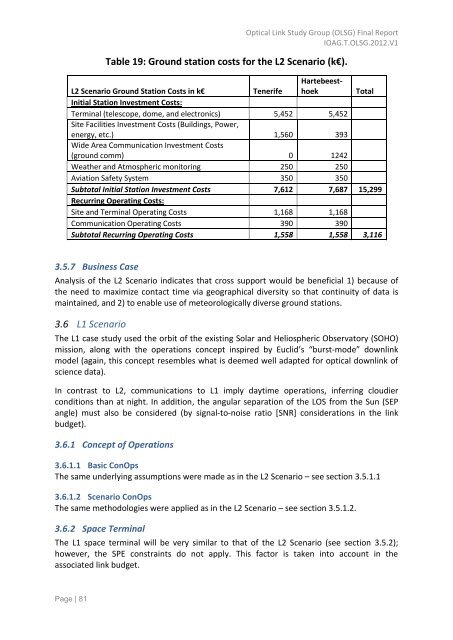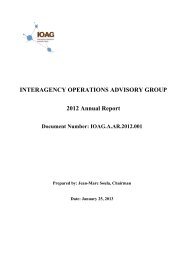OLSG Report_Final_06_05_12 - Interagency Operations Advisory ...
OLSG Report_Final_06_05_12 - Interagency Operations Advisory ...
OLSG Report_Final_06_05_12 - Interagency Operations Advisory ...
You also want an ePaper? Increase the reach of your titles
YUMPU automatically turns print PDFs into web optimized ePapers that Google loves.
Optical Link Study Group (<strong>OLSG</strong>) <strong>Final</strong> <strong>Report</strong><br />
IOAG.T.<strong>OLSG</strong>.20<strong>12</strong>.V1<br />
Table 19: Ground station costs for the L2 Scenario (k€).<br />
L2 Scenario Ground Station Costs in k€<br />
Tenerife<br />
Hartebeesthoek<br />
Total<br />
Initial Station Investment Costs:<br />
Terminal (telescope, dome, and electronics) 5,452 5,452<br />
Site Facilities Investment Costs (Buildings, Power,<br />
energy, etc.) 1,560 393<br />
Wide Area Communication Investment Costs<br />
(ground comm) 0 <strong>12</strong>42<br />
Weather and Atmospheric monitoring 250 250<br />
Aviation Safety System 350 350<br />
Subtotal Initial Station Investment Costs 7,6<strong>12</strong> 7,687 15,299<br />
Recurring Operating Costs:<br />
Site and Terminal Operating Costs 1,168 1,168<br />
Communication Operating Costs 390 390<br />
Subtotal Recurring Operating Costs 1,558 1,558 3,116<br />
3.5.7 Business Case<br />
Analysis of the L2 Scenario indicates that cross support would be beneficial 1) because of<br />
the need to maximize contact time via geographical diversity so that continuity of data is<br />
maintained, and 2) to enable use of meteorologically diverse ground stations.<br />
3.6 L1 Scenario<br />
The L1 case study used the orbit of the existing Solar and Heliospheric Observatory (SOHO)<br />
mission, along with the operations concept inspired by Euclid’s “burst-mode” downlink<br />
model (again, this concept resembles what is deemed well adapted for optical downlink of<br />
science data).<br />
In contrast to L2, communications to L1 imply daytime operations, inferring cloudier<br />
conditions than at night. In addition, the angular separation of the LOS from the Sun (SEP<br />
angle) must also be considered (by signal-to-noise ratio [SNR] considerations in the link<br />
budget).<br />
3.6.1 Concept of <strong>Operations</strong><br />
3.6.1.1 Basic ConOps<br />
The same underlying assumptions were made as in the L2 Scenario – see section 3.5.1.1<br />
3.6.1.2 Scenario ConOps<br />
The same methodologies were applied as in the L2 Scenario – see section 3.5.1.2.<br />
3.6.2 Space Terminal<br />
The L1 space terminal will be very similar to that of the L2 Scenario (see section 3.5.2);<br />
however, the SPE constraints do not apply. This factor is taken into account in the<br />
associated link budget.<br />
Page | 81



